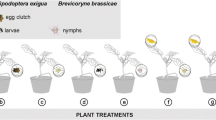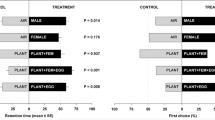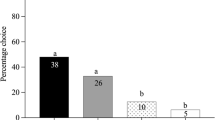Abstract
Specialized natural enemies that forage for polyphagous hosts need to locate hosts on different plants. Telenomus podisi (Hymenoptera: Platygastridae) is a stink bug egg parasitoid with a preference for Euschistus heros (Hemiptera, Pentatomidae), a polyphagous species. The aim of this study was to evaluate the induction of defences in three E. heros host plants: maize (Zea mays), sunflower (Helianthus annuus) and pigeon pea (Cajanus cajan). We hypothesized that E. heros damage to these three plants enhances the attraction of the parasitoid T. podisi as has been observed in other systems. Using Y-tube olfactometer bioassays, we tested parasitoid responses to combinations of the following odour sources: clean air, undamaged plants and plants damaged by stink bug feeding. Volatiles were collected by means of dynamic headspace collection and analysed by gas chromatography coupled to mass spectrometry. T. podisi did not distinguish odours from undamaged plants against air for any of the three plant species. For maize, the parasitoid preferred the odour from herbivore-damaged plants over both clean air and undamaged plants. For sunflower, the parasitoid only preferred the odour of herbivore-damaged plants over the odour of undamaged plants. For pigeon pea, no preferences were observed. Quantitative differences in the volatile profile of damaged and undamaged plants were observed in each plant species. We conclude that sunflower and maize plants, when damaged by E. heros, release volatiles that attract the parasitoid T. podisi; the parasitoid appears to use a different blend composition to distinguish herbivore-damaged plants of each species.



Similar content being viewed by others
References
Borges M, Costa MLM, Sujii ER, Cavalcanti MG, Redígolo GF, Resck IS, Vilela EF (1999) Semiochemical and physical stimuli involved in host recognition by Telenomus podisi (Hymenoptera: Scelionidae) toward Euschistus heros (Heteroptera: Pentatomidae). Physiological Entomology 24:227–233
Borges M, Laumann RA, Silva CC, Moraes MCB, Santo SHM, Ribeiro DT (2006) Metodologias de criação e manejo de colônias de percevejos da soja (Hemiptera: Pentatomidae) para estudos de comportamento e ecologia química. Brasília: Embrapa – Cenargen. 18p. Documentos, n. 182
Bruce TJA, Pickett JA (2011) Perception of plant volatile blends by herbivorous insects—finding the right mix. Phytochemistry 72:1605–1611. doi:10.1016/j.phytochem.2011.04.011
Colazza S, Fucarino A, Peri E, Salerno G, Conti E, Bin F (2004a) Insect oviposition induces volatile emission in herbaceous plants that attracts egg parasitoids. J Exp Biol 207:47–53
Colazza S, McElfresh JS, Millar JG (2004b) Identification of volatile synomones, induced by Nezara viridula feeding and oviposition on bean spp., that attract the egg parasitoid Trissolcus basalis. J Chem Ecol 30:945–964
Copatti JF, Oliveira NC (2011) Danos iniciais causados pelos percevejos Dichelops melacanthus e Euschistus heros (Hemiptera: Pentatomidae) em plantas de milho. Campo Digit Campo Mourão 6:1–8
D’Alessandro M, Brunner V, Gv Mérey, Turlings TCJ (2009) Strong attraction of the parasitoid Cotesia marginiventris towards minor volatile compounds of maize. J Chem Ecol 35:999–1008. doi:10.1007/s10886-009-9692-7
de Boer JG, Hordijk CA, Posthumus MA, Dicke M (2008) Prey and non-prey arthropods sharing a host plant: effects on induced volatile emission and predator attraction. J Chem Ecol 34:281–290
De Moraes CM, Lewis WJ, Paré PW, Alborn HT, Tumlinson JH (1998) Herbivore-infested plants selectively attract parasitoids. Nature 393:570–573
Development Core Team R (2007) R: a language and environment for statistical computing. R Foundation for Statistical Computing, Vienna
Dicke M, Baldwin IT (2010) The evolutionary context for herbivore-induced plant volatiles: beyond the ‘cry for help’. Trends Plant Sci 15:167–175. doi:10.1016/j.tplants.2009.12.002
Du Y-J, Poppy GM, Powell W (1996) Relative importance of semiochemicals from first and second trophic levels in host foraging behavior of Aphidius ervi. J Chem Ecol 22:1591–1605
Fatouros NE, Dicke M, Mumm R, Meiners T, Hilker M (2008) Foraging behavior of egg parasitoids exploiting chemical information. Behav Ecol 19:677–689. doi:10.1093/beheco/arn011
Fritzsche Hoballah ME, Tamò C, Turlings TCJ (2002) Differential attractiveness of induced odors emitted by eight maize varieties for the parasitoid Cotesia marginiventris: is quality or quantity important? J Chem Ecol 28:951–968
Gouinguené S, Degen T, Turlings TCJ (2001) Variability in herbivore-induced odour emissions among maize cultivars and their wild ancestors. Chemoecology 11:9–16
Higuchi H (1992) Population prevalence of occurrence and spatial distribution pattern of Piezodorus hybneri adults (Heteroptera: Pentatomidae) on soybeans. Appl Entomol Zool 27:363–369
Hilker M, McNeil JN (2008) Chemical and behavioral ecology in insect parasitoids: how to behave optimally in a complex odorous environment. In: Wajnberg E, Bernstein C, Van Alphen JJM (eds) Behavioral ecology of insect parasitoids: from theoretical approaches to field applications. Blackwell, Malden, pp 97–100
Hilker M, Meiners T (2010) How do plants ‘‘notice’’ attack by herbivorous arthropods? Biol Rev 85:267–280. doi:10.1111/j.1469-185X.2009.00100.x
Hilker M, Kobs C, Varama M, Schrank K (2002) Insect egg deposition induces Pinus sylvestris to attract egg parasitoids. J Exp Biol 205:455–461
Karban R, Myers JH (1989) Induced plant-responses to herbivory. Annu Rev Ecol Syst 20:331–348
Kariyat RR, Mauck KE, De Moraes CM, Stephenson AG, Mescher MC (2012) Inbreeding alters volatile signalling phenotypes and influences tri-trophic interactions in horsenettle (Solanum carolinense L.). Ecol Lett 15:301–309. doi:10.1111/j.1461-0248.2011.01738.x
Koornneef A, Pieterse CMJ (2008) Cross talk in defense signaling. Plant Physiol 146:839–844. doi:10.1104/pp.107.112029
Laumann RA, Aquino MFS, Moraes MCB, Pareja M, Borges M (2009) Response of the egg parasitoids trissolcus basalis and Telenomus podisi to compounds from defensive secretions of stink bugs. J Chem Ecol 35:8–19. doi:10.1007/s10886-008-9578-0
Laumann RA, Cokl A, Lopes APS, Fereira JBC, Moraes MCB, Borges M (2011) Silent singers are not safe: selective response of a parasitoid to substrate-borne vibratory signals of stink bugs. Anim Behav 82:1175–1183. doi:10.1016/j.anbehav.2011.08.017
Lopes APS, Diniz IR, Moraes MCB, Borges M, Laumann RA (2012) Defesas induzidas por herbivoria e interações específicas no sistema tritrófico soja percevejos parasitoides de ovos. Pesquisa Agropecuária Brasileira 47:875–878
Malaguido AB, Panizzi AR (1998) Damage of Euschistus heros (F.) (Hemiptera: Pentatomidae) to sunflower seeds. Anais da Sociedade Entomológica do Brasil 27:535–541
McCormick AC, Unsicker SB, Gershenzon J (2012) The specificity of herbivore-induced plant volatiles in attracting herbivore enemies. Trends Plant Sci 17:303–310. doi:10.1016/j.tplants.2012.03.012
Melo Machado RC, Sant’Ana J, Blassioli-Moraes MC, Laumann RA, Borges M (2014) Herbivory-induced plant volatiles from Oryza sativa and their influence on chemotaxis behaviour of Tibraca limbativentris Stal. (Hemiptera: Pentatomidae) and egg parasitoids. Bull Entomol Res 104:347–356. doi:10.1017/S0007485314000133
Michereff MFF, Laumann RA, Borges M, Michereff-Filho M, Diniz IR, Neto ALF, Moraes MCB (2011) Volatiles mediating a plant-herbivore-natural enemy interaction in resistant and susceptible soybean cultivars. J Chem Ecol 37:273–285. doi:10.1007/s10886-011-9917-4
Michereff MFF, Borges M, Laumann RA, Diniz IR, Neto ALF, Moraes MCB (2013) Influence of volatile compounds from herbivore-damaged soybean plants on searching behavior of the egg parasitoid Telenomus podisi. Entomol Exp Appl 147:9–17
Moraes MCB, Laumann R, Sujii ER, Pires C, Borges M (2005) Induced volatiles in soybean and pigeon pea plants artificially infested with the neotropical brown stink bug, Euschistus heros, and their effect on the egg parasitoid, Telenomus podisi. Entomol Exp Appl 115:227–237
Moraes MCB, Pareja M, Laumann RA, Hoffmann-Campo CB, Borges M (2008) Response of the parasitoid Telenomus podisi to induced volatiles from soybean damaged by stink bug herbivory and oviposition. J Plant Interact 3:111–118
Moraes MCB et al (2009) Attraction of the stink bug egg parasitoid Telenomus podisi to defence signals from soybean activated by treatment with cis-jasmone. Entomol Exp Appl 131:178–188. doi:10.1111/j.1570-7458.2009.00836.x
Mumm R, Hilker M (2005) The significance of background odour for an egg parasitoid to detect plants with host eggs. Chem Senses 30:337–343. doi:10.1093/chemse/bji028
Mumm R, Schrank K, Wegener R, Schulz S, Hilker M (2003) Chemical analysis of volatiles emitted by Pinus sylvestris after induction by insect oviposition. J Chem Ecol 29:1235–1252
NIST (2008) NIST/EPA/NIH Mass Spectral Library 2008
Ode PJ (2013) Plant defences and parasitoid chemical ecology. In: Wajnberg E, Colazza S (eds) Chemical ecology of insect parasitoids. Wiley, Oxford, pp 11–36
Panizzi AR (1997) Wild hosts of pentatomids: ecological significance and role in their pest status on crops. Annu Rev Entomol 42:99–122
Panizzi AR, Vivan LM (1997) Seasonal abundance of the neotropical brown stink bug, Euschistus heros, in overwintering sites, and the breaking of dormancy. Entomol Exp Appl 82:213–217
Pareja M, Mohib A, Birkett MA, Dufour S, Glinwood RT (2009) Multivariate statistics coupled to generalized linear models reveal complex use of chemical cues by a parasitoid. Anim Behav 77:901–909. doi:10.1016/j.anbehav.2008.12.016
Pashalidou FG, Huigens ME, Dicke M, Fatouros NE (2010) The use of oviposition-induced plant cues by Trichogramma egg parasitoids. Ecol Entomol 35:748–753. doi:10.1111/j.1365-2311.2010.01235.x
Piñero JC, Dorn S (2007) Synergism between aromatic compounds and green leaf volatiles derived from the host plant underlies female attraction in the oriental fruit moth. Entomol Exp Appl 125:185–194
Rodriguez-Saona C, Kaplan I, Braasch J, Chinnasamy D, Williams L (2011) Field responses of predaceous arthropods to methyl salicylate: a meta-analysis and case study in cranberries. Biol Control 59:294–303. doi:10.1016/j.biocontrol.2011.06.017
Rodríguez-Saona C, Chalmers JA, Raj S, Thaler JS (2005) Induced plant responses to multiple damagers: differential effects on an herbivore and its parasitoid. Oecologia 143:566–577
Silva CC, Laumann RA, Blassioli MC, Pareja M, Borges M (2008) Euschistus heros mass rearing technique for the multiplication of Telenomus poldisi. Pesquisa Agropecuária Brasileira 43:575–580
Storeck A, Poppy GM, van Emden HF, Powell W (2000) The role of plant chemical cues in determining host preference in the generalist aphid Aphidius colemani. Entomol Exp Appl 97:41–46
Sujii ER, Costa MLM, Pires CSS, Colazza S, Borges M (2002) Inter and intra-guild interactions in egg parasitoid species of the soybean stink bug complex. Pesquisa Agropecuária Brasileira 37:1541–1549
Tillman PG, Northfield TD, Mizell RF, Riddle TC (2009) Spatiotemporal patterns and dispersal of stink bugs (Heteroptera: Pentatomidae) in peanut-cotton farmscapes. Environ Entomol 38:1038–1052
van Poecke RMP, Dicke M (2004) Indirect defence of plants against herbivores: using Arabidopsis thaliana as a model plant. Plant Biol 6:387–401
Vet LEM, Dicke M (1992) Ecology of infochemical use by natural enemies in a tritophic context. Annu Rev Entomol 37:141–172
Wäschke N, Meiners T, Rostás M (2013) Foraging strategies of parasitoids in complex chemical environments. In: Wajnberg E, Colazza S (eds) Chemical ecology of insect parasitoids. Wiley, Chichester, pp 37–63
Acknowledgments
This work received financial support from the Conselho Nacional de Desenvolvimento Científico e Tecnológico—CNPq, through a studentship to AMD, as well as grants from Embrapa, CNPq and FAP-DF. MP was supported by a FAEPEX-PAPDIC grant from UNICAMP.
Author information
Authors and Affiliations
Corresponding author
Additional information
Handling Editor: Jarmo Holopainen.
Rights and permissions
About this article
Cite this article
Dias, A.M., Pareja, M., Laia, M. et al. Attraction of Telenomus podisi to volatiles induced by Euschistus heros in three different plant species. Arthropod-Plant Interactions 10, 419–428 (2016). https://doi.org/10.1007/s11829-016-9453-9
Received:
Accepted:
Published:
Issue Date:
DOI: https://doi.org/10.1007/s11829-016-9453-9




